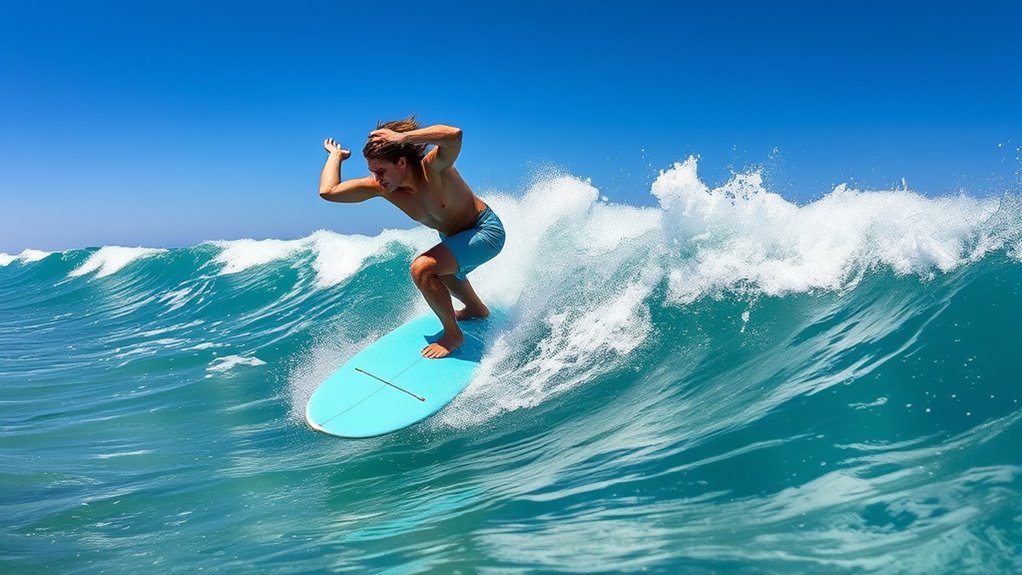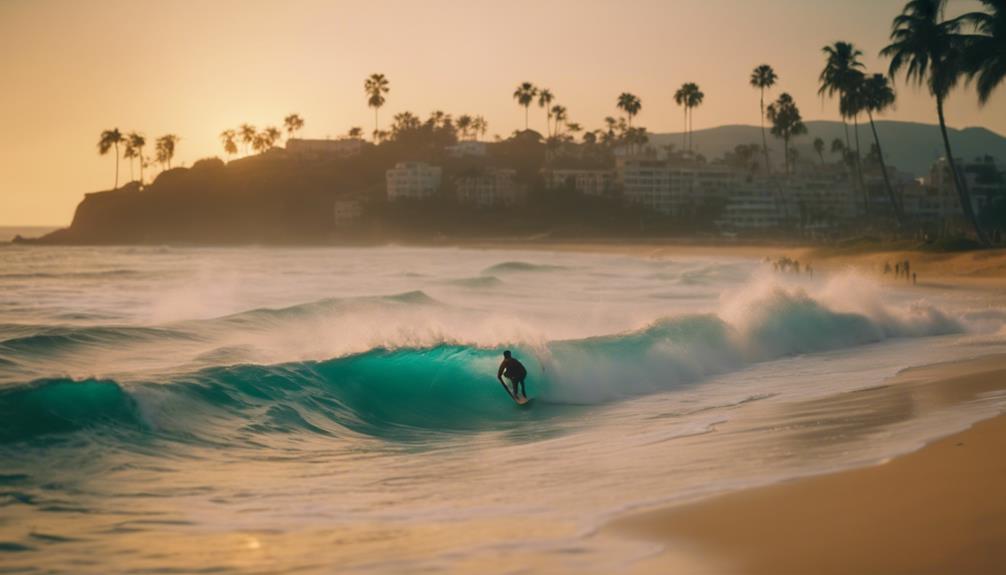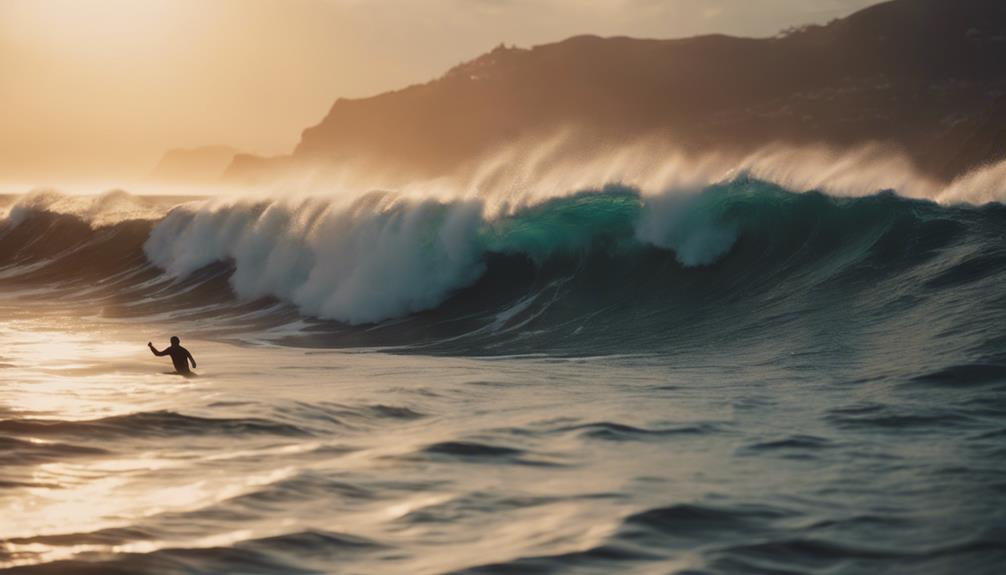To pop up on a surfboard, start lying flat with your hands firmly on the rails, elbows close to your sides, and your eyes up. Engage your core and time your push with the wave’s momentum, then quickly push up with your hands, swinging your feet forward to land flat on the board. Keep your balance by maintaining a centered stance, with knees bent and weight distributed evenly. If you want to master a smooth, confident pop-up, keep exploring these key steps.
Key Takeaways
- Place hands flat near your chest with elbows close to your sides to prepare for the push-up motion.
- Engage your core and push up with your arms, timing the movement with wave momentum.
- Swing your feet rapidly forward, landing flat on the deck with feet shoulder-width apart.
- Keep your knees bent and distribute your weight evenly, with more on the front foot during the pop.
- Maintain a smooth, fluid motion, focusing on balance and stability as you stand upright.
Get Comfortable on Your Surfboard
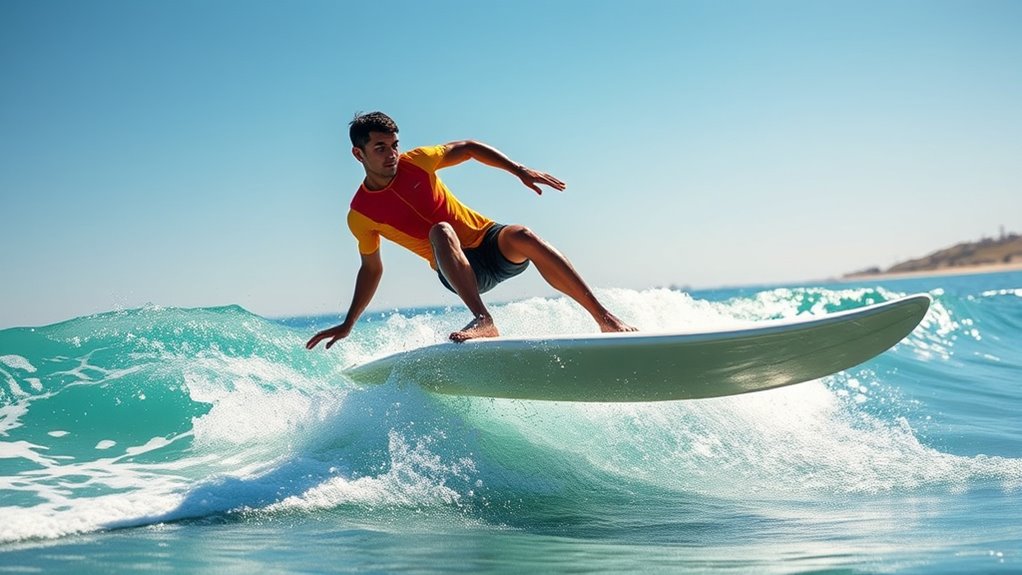
To get comfortable on your surfboard, you should spend time simply lying on it in the water. This helps you get used to its board design, feeling how it floats and responds beneath you. Make sure your surfboard wax is properly applied to prevent slipping, giving you better grip as you practice positioning yourself. As you lie on the board, notice how different shapes and sizes affect stability and ease of paddling. Experiment with shifting your weight slightly to understand how the board reacts. This familiarity builds confidence, making it easier to *progress* into standing later. Take your time to find a comfortable, balanced stance while lying on your board, as this foundation is key to successfully popping up when the time comes. Understanding the contrast ratio of your setup can also help optimize visual feedback and confidence during practice. Additionally, exploring protective styling options like crochet styles for locs can enhance your comfort and confidence while practicing in the water. Incorporating appropriate gear such as wetsuits or rash guards can further improve your comfort level and safety during your surf sessions. Being aware of your surf environment can also help you adapt your practice to different conditions and improve overall safety.
Practice Paddling Out and Duck Diving
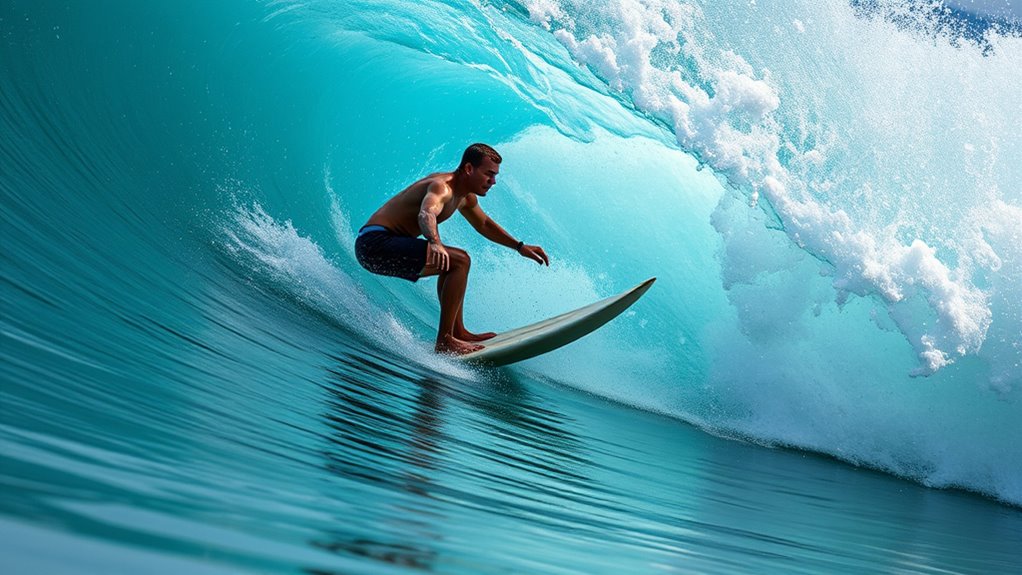
Once you’re comfortable lying and paddling on your surfboard, it’s time to focus on getting out to the lineup and handling larger waves. Practice paddling out by reading the waves—look for the ones that will carry you out without too much effort. Use proper equipment selection to match your skill level and wave conditions; a slightly larger board can make paddling easier. To get through the surf zone, work on duck diving: push the nose down as the wave approaches, then kick your legs to submerge the board. Key tips include:
- Focus on wave reading to anticipate how to navigate
- Choose equipment suited for your size and skill
- Paddle with smooth, even strokes
- Practice duck diving consistently
- Maintain a low, balanced stance during duck dives
- Consider hydrocolloid patches options to stay entertained or receive coaching tips while on the water.
Additionally, understanding privacy policies can help you manage your data and enhance your online experience when researching surfing techniques.
Find the Right Position for Your Feet
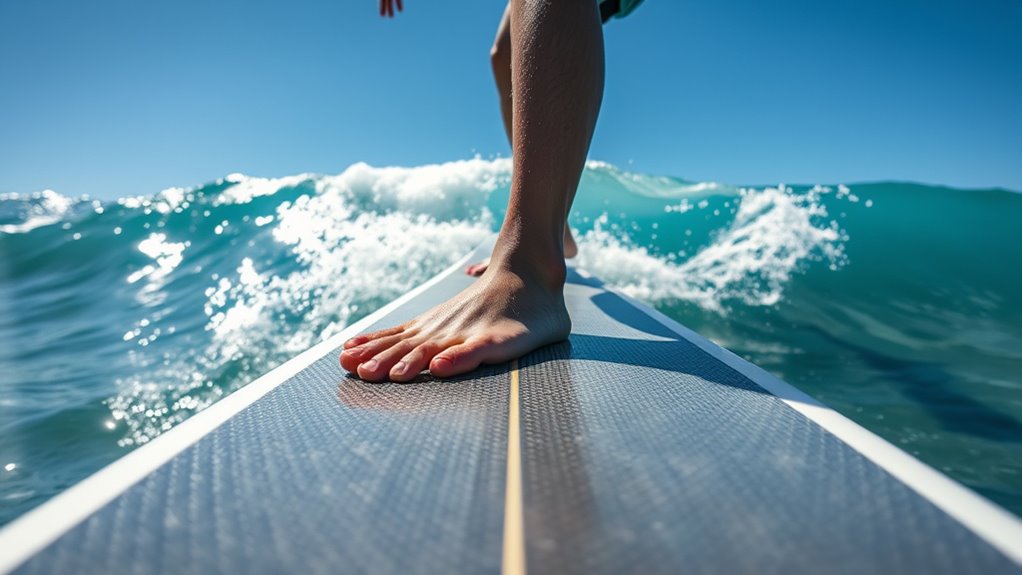
Finding the right position for your feet is essential to maintain balance and control as you pop up on your surfboard. Proper foot placement ensures stability and helps you transition smoothly from lying to standing. Start by placing your feet roughly shoulder-width apart, with your toes pointing slightly outward. Your front foot should be positioned over the stringer or centered on the board’s width, while your back foot lands near the tail for leverage. Remember, stance adjustment is key: if you feel wobbly, try changing your foot positioning until it feels natural and balanced. Small tweaks can make a big difference in your control and confidence. Focus on keeping your weight centered and your feet firmly planted as you prepare for the next move. Additionally, understanding how your stance alignment affects your overall stability can greatly improve your surfing technique.
The Push-Up Motion: From Lying to Standing
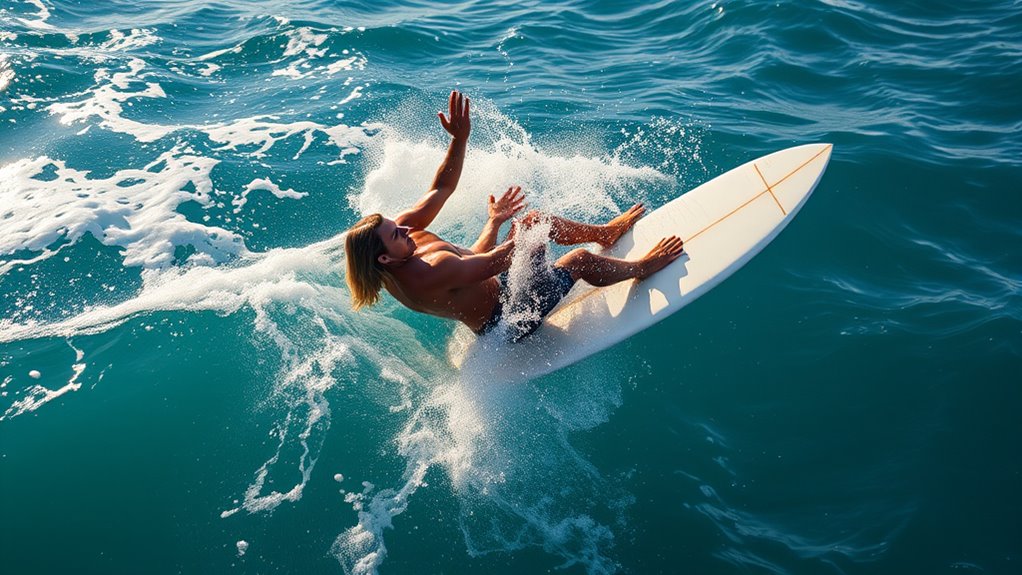
When you’re ready to pop up, start by placing your hands flat on the board near your chest. Use your paddle technique to help generate momentum, and pay attention to wave timing so you know when to act. From the lying position, push yourself up quickly while keeping your eyes on the horizon. As you lift, keep your elbows close to your body to maintain control. To improve your pop-up:
- Focus on timing your push with the wave’s peak
- Keep your core engaged for balance
- Use your arms to propel yourself upward
- Practice the motion repeatedly for muscle memory
- Maintain a smooth, fluid progression from lying to standing
- Vibe coding techniques can help you develop a more intuitive feel for wave patterns and improve your timing. Additionally, mastering your pop-up motion is essential for transitioning smoothly onto your feet and maintaining stability during your ride. Incorporating wave pattern recognition can further enhance your ability to anticipate and respond to changing surf conditions, especially when combined with timing awareness.
Swing Your Feet Forward and Stand Up
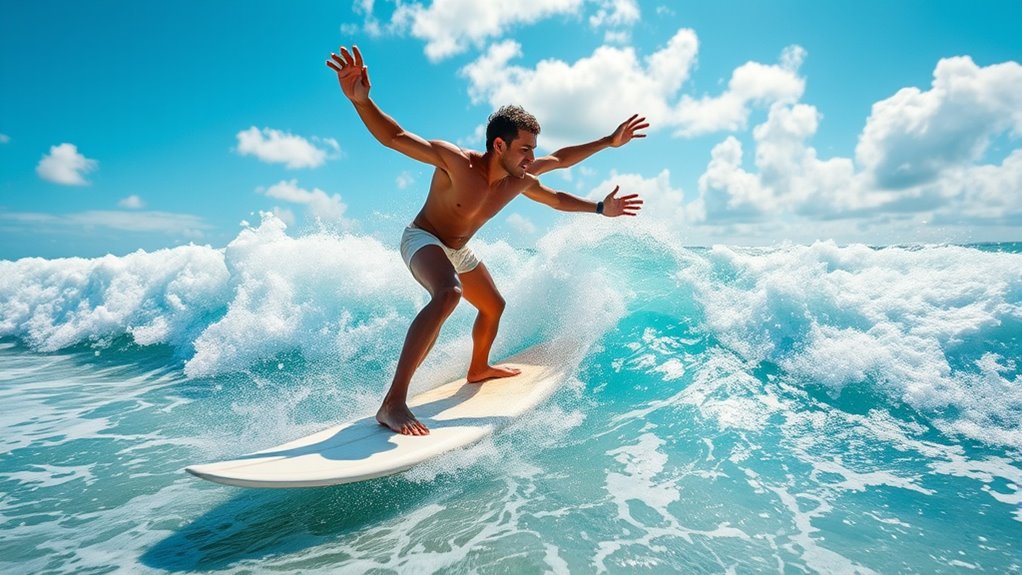
Once you’ve pushed up with your hands, quickly swing your feet forward toward the surfboard. Keep the movement smooth and fast to maintain balance. As your feet land, rise to a standing position in one fluid motion.
Push up With Hands
To successfully pop up on your surfboard, start by placing your hands firmly on the deck, just outside your shoulders. Focus on proper hand placement and keep your elbows close to your sides. As you push up, engage your core to maintain stability and control. This will help you lift your chest and shoulders smoothly. Keep your head down and look forward as you push through your hands. Remember, a strong core makes the movement more efficient and balanced.
- Position your hands evenly on the deck
- Keep elbows tight to your body
- Use core muscles to push up powerfully
- Keep your shoulders over your hands
- Maintain a steady, controlled motion for balance
Swing Feet Forward Rapidly
After pushing up on the board, quickly swing your feet forward so they land flat on the deck, about shoulder-width apart. This rapid movement is vital for maintaining momentum and balance. As you swing your feet, focus on keeping your movements smooth yet swift, ensuring your feet land securely. Use your core to help control the motion, avoiding any hesitation. The goal is to get your feet beneath your body as fast as possible, so you’re ready to stand up without losing your position on the wave. Remember, a quick and controlled swing of your feet helps set the foundation for a successful pop-up. Developing bike handling skills can improve your overall stability and confidence during this transition. Practicing this motion enhances your balance and coordination, which are essential for a smooth transition from lying to standing. Incorporating proper body positioning is essential to achieve a fluid transition and maintain stability as you rise. Additionally, understanding the importance of core strength can help you generate the power needed for a quick and effective pop-up. Building strength and muscle memory through consistent practice will make this movement more natural over time.
Rise to Standing Position
As you swing your feet forward, focus on pushing your hips up and onto your hands, then smoothly shift into standing. Your surfboard’s design influences your balance and stability during this move, so choose a shape that suits your skill level. Keep in mind that surfboard materials, like foam or epoxy, affect how responsive and lightweight your board feels, making it easier to pop up. To improve your rise:
- Keep your eyes up and look forward
- Place your hands firmly on the board’s rails
- Engage your core for stability
- Use your back foot to help lift your hips
- Practice timing your pop to match the wave’s momentum
- Understanding surfboard materials can help you select the best board for your skill level and environmental considerations, such as air pollution and sustainability. Being aware of air purification technologies can also contribute to making eco-friendly choices when selecting a surfboard, supporting sustainability efforts. Additionally, choosing performance-enhancing components can improve your overall surfing experience. Recognizing the importance of safety precautions can help prevent injuries during this transition.
Maintain Balance and Find Your Stance
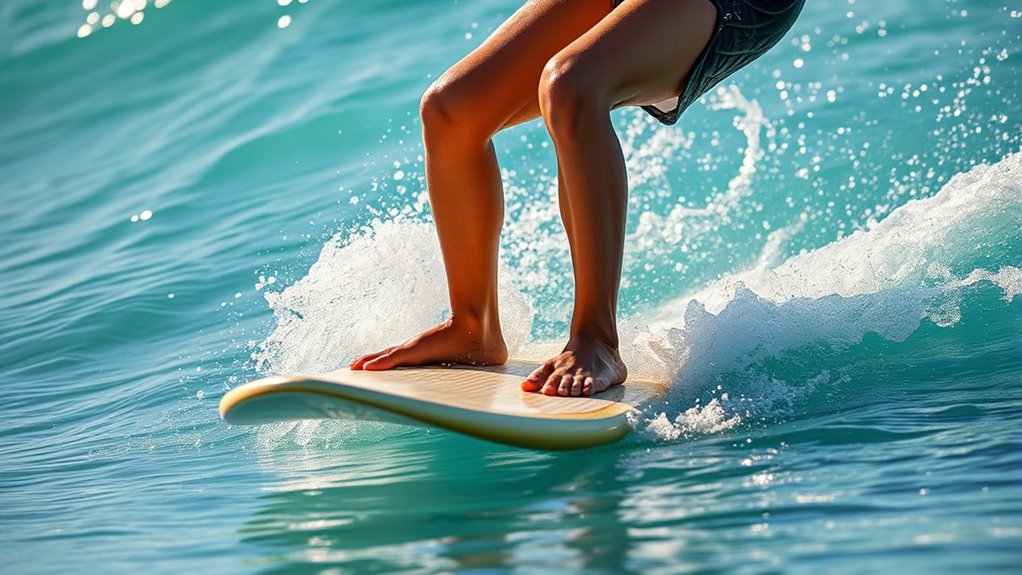
Maintaining balance and finding your stance are essential steps before popping up on a surfboard. Focus on engaging your core to stay stable and control your movements. Proper weight distribution helps you stay centered, preventing falls. To find your stance, position your feet shoulder-width apart, with your dominant foot slightly forward. Keep your knees bent and your weight evenly spread, with more weight on your front foot during the pop-up. Practice shifting your weight smoothly to stay balanced on the board. Use this table to visualize key points:
| Step | Focus | Tip |
|---|---|---|
| Core engagement | Stay stable and controlled | Tighten abs during pop-up |
| Weight distribution | Balance front and back | Lean forward slightly |
| Foot placement | Find your stance | Keep feet aligned and firm |
| Balance maintenance | Stay centered on board | Use arms for balance |
Frequently Asked Questions
How Long Does It Typically Take to Master the Pop-Up?
Mastering the pop-up varies for everyone, but with consistent practice, you’ll see progress faster. It generally takes weeks to develop the timing consistency and muscle memory needed to perform a smooth pop-up. You might notice improvements in just a few sessions, but truly feeling confident can take longer. Keep practicing regularly, focus on your technique, and you’ll find your pop-up becoming quicker and more natural over time.
What Are Common Mistakes Beginners Make During the Pop-Up?
When you try to pop up, you might rush or forget proper foot placement, making it harder to balance. Common mistakes include not positioning your arms correctly, which affects your stability and timing. You may also lift your head too early or push off with the wrong foot. Focus on keeping your arms strong and your feet properly placed, and practice smooth, controlled movements to improve your pop-up.
Can I Practice the Pop-Up on Land First?
Ever wonder if you can master the pop-up away from the waves? Absolutely! You can practice land drills to build your muscle memory and improve your balance. Start by lying on a flat surface, then push up quickly to a standing position, mimicking the pop-up motion. This land practice helps you develop confidence and coordination, making your actual surf pop-up smoother and more instinctive when you’re on the water.
How Do Wave Conditions Affect the Popping Technique?
Wave conditions, like wave height and swell direction, play a big role in your popping technique. When waves are taller, you need to time your pop-up carefully to avoid being pushed back. If the swell comes from a favorable direction, it’ll help you catch the wave smoothly, making your pop-up easier. Adjust your timing and stance based on these conditions to improve your balance and get onto the wave more effectively.
What Equipment Adjustments Can Improve My Pop-Up Success?
Imagine you’re in a vintage surf movie—your gear makes a difference. To improve your pop-up success, focus on equipment adjustments like enhancing your board grip for better control and increasing paddle speed to catch waves earlier. A well-chosen leash or wax can also boost confidence. These tweaks help you stay balanced and quick on your feet, making your pop-up smoother and more consistent every time you ride.
Conclusion
With patience and practice, popping up on your surfboard will become second nature. Remember, it’s normal to feel unsteady at first—don’t get discouraged. Focus on smooth, controlled movements rather than speed, and you’ll build confidence over time. If you slip or wobble, simply reset and try again. Mastering the pop-up takes dedication, but once you get it, you’ll enjoy catching waves with greater ease and control.

